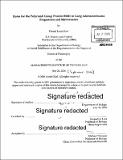| dc.contributor.advisor | Jacqueline Lees. | en_US |
| dc.contributor.author | Karl, Daniel Louis | en_US |
| dc.contributor.other | Massachusetts Institute of Technology. Department of Biology. | en_US |
| dc.date.accessioned | 2017-01-30T19:15:53Z | |
| dc.date.available | 2017-01-30T19:15:53Z | |
| dc.date.copyright | 2016 | en_US |
| dc.date.issued | 2016 | en_US |
| dc.identifier.uri | http://hdl.handle.net/1721.1/106732 | |
| dc.description | Thesis: Ph. D., Massachusetts Institute of Technology, Department of Biology, 2016. | en_US |
| dc.description | Cataloged from PDF version of thesis. | en_US |
| dc.description | Includes bibliographical references. | en_US |
| dc.description.abstract | The B lymphoma Mo-MLV insertion region 1 homolog (Bmil) protein is implicated as an oncogene in a variety of human cancers. During normal development, Bmil acts as part of a transcriptional repressive complex that regulates processes such as stem cell self-renewal, cell-fate commitment, and proliferation. During tumorigenesis, many cancers co-opt these core Bmil functions. A subset of these malignancies demonstrates an increased dependence on Bmil, revealing a window of vulnerability that could be exploited for the therapeutic benefit of patients. With the advent of cancer genomics, we have begun to appreciate the complex molecular determinants that inform these therapeutic windows. Indeed, Bmil is now understood to play unique roles depending on the underlying genetic contexts of tissue type, developmental stage, and of individual tumors. With this in mind, in this thesis I used mouse models of oncogenic Kras driven lung cancer to explore the potential dependence of lung adenocarcinoma, among the deadliest of cancers, on Bmil for tumor initiation, progression, and maintenance. Specifically, I demonstrate that Bmil is dispensable for tumor initiation but mediates the transition to advanced disease and thereby impacts the overall survival of tumor bearing animals. I show that Bmil is required to sustain the proliferative capacity of Kras driven lung adenomas. In part, it does so by enforcing efficient progression through the cell cycle independent of a canonical target, the pl9ARF-p53 tumor suppressive axis. This creates a large potential therapeutic window, as half of all lung adenocarcinoma patients display p53 mutations. My gene expression analyses further establishes a critical role for Bmil in the repression of developmental regulators, which may contribute to the atypical differentiation state of tumors as they adapt to the loss of Bmil. Finally, using both mouse models and cell lines, I present evidence that a subset of advanced tumors are sensitive to the loss of Bmil. Overall, this thesis advances our understanding of the genetic dependencies of Bmil in lung cancers and reveals novel mechanisms that potentially can be exploited to combat this deadly of disease. | en_US |
| dc.description.statementofresponsibility | by Daniel Louis Karl. | en_US |
| dc.format.extent | 182 pages | en_US |
| dc.language.iso | eng | en_US |
| dc.publisher | Massachusetts Institute of Technology | en_US |
| dc.rights | MIT theses are protected by copyright. They may be viewed, downloaded, or printed from this source but further reproduction or distribution in any format is prohibited without written permission. | en_US |
| dc.rights.uri | http://dspace.mit.edu/handle/1721.1/7582 | en_US |
| dc.subject | Biology. | en_US |
| dc.title | Roles for the polycomb group protein BMI1 in lung adenocarcinoma progression and maintenance | en_US |
| dc.type | Thesis | en_US |
| dc.description.degree | Ph. D. | en_US |
| dc.contributor.department | Massachusetts Institute of Technology. Department of Biology | |
| dc.identifier.oclc | 969272668 | en_US |
